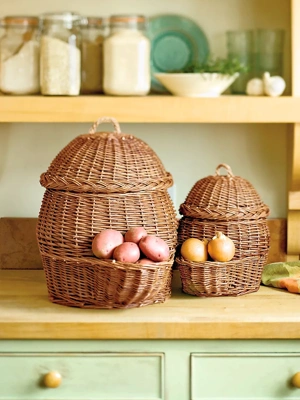Willow Garden Accents
A tradition made new
Woven fences, garden enclosures, harvest baskets, cloches, trellises, roof thatches and shelters have a long history in the British Isles — and elsewhere. From ancient to modern times, farmers and gardeners have enclosed their pastures and vegetable gardens with sustainable, homegrown and locally harvested fence materials. This traditional practice is enjoying a resurgence as practical, beautiful and functional DIY projects and garden decor.
Containing the Garden
Low frames or wattles made of woven willow and other woods grown for this purpose have been used for millennia to contain raised beds and garden allotments throughout Great Britain. They tidy the garden edges and help keep soil in place.
 You can make your own wattles and surround a modern planter to create a medieval herb garden.
You can make your own wattles and surround a modern planter to create a medieval herb garden.In taller versions of natural woven fences or portable panels, called hurdles, the pliable willow or hazel wands are woven between fence posts, either set in the ground or freestanding. By using different species, dimensions and colors of willow, a weaver can even create horizontal stripes and patterns. Depending on the materials used and skills of the craftsman, the weaving may be rough and rustic or quite sophisticated. The resulting barriers last for years and were historically used to temporarily contain animals and, more recently to screen utility areas and other unwelcome views. Hurdles and freestanding fence panels can also be placed over a pergola as a roof to cast welcome shade.
 With the Willow Cloche, you can protect tender seedlings from rabbits and other critters until they are more established.
With the Willow Cloche, you can protect tender seedlings from rabbits and other critters until they are more established.Lending Support
Woven wands can perform many other essential garden duties. A graceful gathering of willow stems provides support to sweet peas, while willow hoops hold poppies and peonies in place. Inspired by timeless English designs, willow supports and willow obelisks look natural in any garden setting.
No matter how noble or humble the garden -- from medieval monastery gardens to royal estates to urban community gardens -- woven wood is at home in the landscape. Its practical, sustainable and flexible nature continues to weave its way into the heart of the garden.

The tradition today: willow fence panels at a garden center in England
Working Woodlands
When the main trunk is cut down, certain tree species — such as willow and hazel — quickly grow new thickets of straight, pliable shoots from the stumps. The practice of coppicing, or repeatedly cutting stems to near ground level, has been a critical woodland management tool since ancient times.
Depending on the species of tree and its intended use, the shoots of these "perpetually young" trees are harvested on a rotation of one year to more than 20 years. Trees in well-managed, coppiced woodlands actually live much longer than trees left uncut and they serve as a renewable source of fuel and building materials for many decades — even centuries. Coppiced woodlands also provide critical habitat for many bird, animal and insect species.
Last updated: 03/08/2024
Print this Article:
Related items
Get the Dirt
Stay up to date on new articles and advice. Please fill out the information below.




